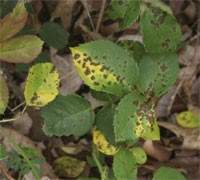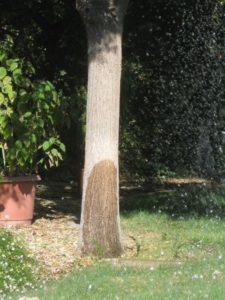Beware: A Fungus Among Us
Have you noticed discolored spots on the bottom foliage of your roses or shrubs? Do any of your trees have an arch of discolored lower bark? If so, you need to take action now!
Wet foliage is susceptible to fungus and other detrimental plant pathogens! No one likes to be cold and wet, including your plants. During this chilly and cloudy time of the year plants often don’t get the chance to fully dry off like they do on a warm sunny day. Tree’s trunks don’t absorb water for the purpose of growth and neither does the foliage of your roses or shrubs. Always target the root zone when irrigating, this is where water absorbing roots are located. If your sprinkler heads are spraying your plants foliage rather than their roots, give us a call so we can re-direct the heads for you.
Black Spot
Black spot is a fungal disease that can defoliate or even kill some rose varieties. First, you’ll see small red and brown spots appear which grow larger and turn into larger black spots on the leaf tissue. Next, the leaf will turn yellow and fall off the bush. Spores are produced on the black spots in as little as 11 days after the spots first appear. Irrigation which hits the black spots spreads the spores to other leaves. Black spot spores germinate and infect leaves within 7 hours of the leaf being wet. To decrease severity of black spot, reduce the amount of time the leaves are wet. If you’re currently watering very early in the morning you might want to adjust to later in the morning when it’s warmer. Space your plants appropriately for good air flow to help them dry. Most importantly, don’t have your sprinkler heads pointing directly at any foliage.
Tree Stress
Tree stress is any condition that causes a decline in your tree’s health. Tree health is dependent upon the same factors as plant health; sufficient water, good air movement, drainage, optimal temperature and light, and nutrient availability. Too much or too little of these factors can cause stress. Site and/or environment conditions are the most common causes of tree stress. Symptoms of stress may include reduced growth, premature leaf drop, abnormal foliage color, or vigorous water sprouting. Irrigation spray directly on the trunk of a tree can be a chronic stress that can lead to both abiotic or biotic problems. If you notice your irrigation system is currently soaking your tree’s trunks, let us know so we can re-direct them or install a bubbler for your tree.
While you may not think much of your irrigation this time of year it’s important to stay vigilant and alert for potential plant health care issues. From prevention to treatment, we have you covered. Stay dry!



